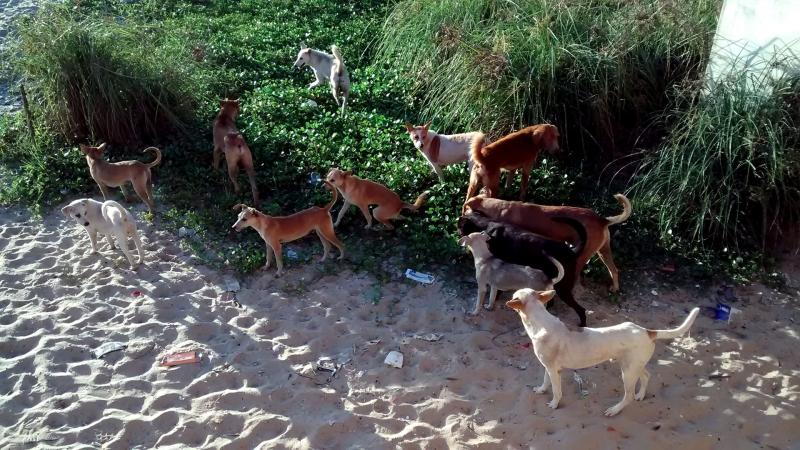
Study finds dogs interact with humans with higher confidence when they are in groups
In a human-dominated world, animals deserve praise for having devised grand strategies to survive. Unlike some of us, who fuss about their mere existence, animals change their natural behaviour in the presence of humans. Studies have shown that monkeys have developed unique gestures to communicate with us, and hedgehogs have changed their foraging behaviour to avoid crowded areas in daylight. Birds are not far behind; some of them use high pitched calls in noisy environments to make themselves heard.
Now, a new study by researchers at the Indian Institute of Science Education and Research (IISER) Kolkata, shows that dogs too have developed strategies to coexist with humans, and numbers play a role in it. The study, published in the journal Behaviour, has analysed how free-ranging dogs interact with humans when they are in a group as against being solitary. Funded by the Department of Science and Technology, the findings have implications on our understanding of social behaviour in animals.
“A central question in understanding the evolution of social behaviour is why animals are social. For any species that displays group-living behaviour, it is interesting to understand how being in a group might be advantageous to the animal, as opposed to being solitary,” says Prof Anindita Bhadra from IISER Kolkata. She is the Principal Investigator of the Dog Lab in IISER Kolkata and has been studying the behaviour of India’s free-ranging dogs for the last decade.
Free-ranging dogs (Canis lupus familiaris) make up about three-quarters of all dogs found in the world. Colloquially referred to as stray dogs, they live close to human habitations where they scavenge for food. They are not ‘owned’ by humans, unlike pets, but are known to interact with humans around them. Free-ranging dogs are known to live in joint families, where members are related and play a role in caregiving.
“Living in groups or packs for the free-ranging dogs might have an adaptive advantage from the context of interspecific interaction, especially when it comes to dealing with negative stimuli from humans,” says Mr Debottam Bhattacharjee, the lead author of the study.
In this study, the researchers compared how dogs responded to friendly and threatening social cues by humans when in groups and when they are solitary. They used results from their previous study on responses to humans by lone dogs and contrasted it with their observations from 80 adult-only dog groups in parts of West Bengal.
In their experiments, the researchers approached unfamiliar dog groups with one of three social cues. They showed either a friendly gesture, where the experimenter bent down with stretched arms to call out the dogs, or a low-threatening gesture akin to how people raise their hands to shoo away dogs, or a high-threatening gesture where the experimenter raised a stick in his hand. Once the dogs were approached with one of these cues, he handed some bits of chicken to see if these dogs would eat them. The experiments were video-recorded and these videos were analysed to note the time the dogs spent gazing at the experimenter and eating the food that was handed to them.
The study found that when approached with a friendly clue, dogs in group gazed longer at the experimenter and were more likely to come closer to him than solitary ones. Gazing was also the first behaviour they exhibited when they saw a low-threatening cue. The dogs also spent a long time with the experimenter and proceeded to grab their treat faster, when approached with a friendly signal. The observations were similar when they were shown a shooing cue.
When the dogs were threatened with a stick in hand, those in a group, and those alone, appeared scared. They made little eye contact with the experimenter and were wary of approaching him. Interestingly, when food was offered after this high-threatening gesture, lone dogs stayed away. However, that was not the case with a group of dogs.
“Here, the dogs approached and took the food, which they never did singly. The surprise was to see how much confidence they gained from being in the group,” remarks Prof Bhadra.
The study also observed that only one dog in the group was found to eat the food. Although there are no established ranks of members in dog groups, this behaviour indicates some hierarchy among them, say the researchers.
“There are more subtle cues, which we are now trying to understand through further observations and experiments,” says Prof Bhadra, talking about their findings.
If you are not used to dogs, the sight of a group of dogs may be intimidating. Does this group-derived-confidence add to this scary picture of dogs? “They might indeed be more aggressive in a pack. However, during the study, we hardly encountered any aggression,” says Prof Bhadra. In fact, across studies, the researchers have seen “very little aggression from dogs towards humans and much higher levels of aggression in the other direction.”
The findings of the study add another piece to the larger puzzle of dog-human interactions and the evolution of dogs.
“In our previous study, we showed that dogs understand subtle and complex pointing cues provided by humans. Here, we show that they respond differently to the same set of social cues from humans, depending on whether they are alone or with group members. This is very interesting because it somehow suggests that they are very well adjusted to human behaviour,” comments Prof Bhadra.
The study also shows the advantages of group living in the animal world, despite the competition that comes with it.
“In our study, the dogs seem to gain confidence in the presence of the group members. It is interesting from the perspective of social behaviour in general,” signs off Dr Bhadra.
This article has been run past the researchers, whose work is covered, to ensure accuracy.





